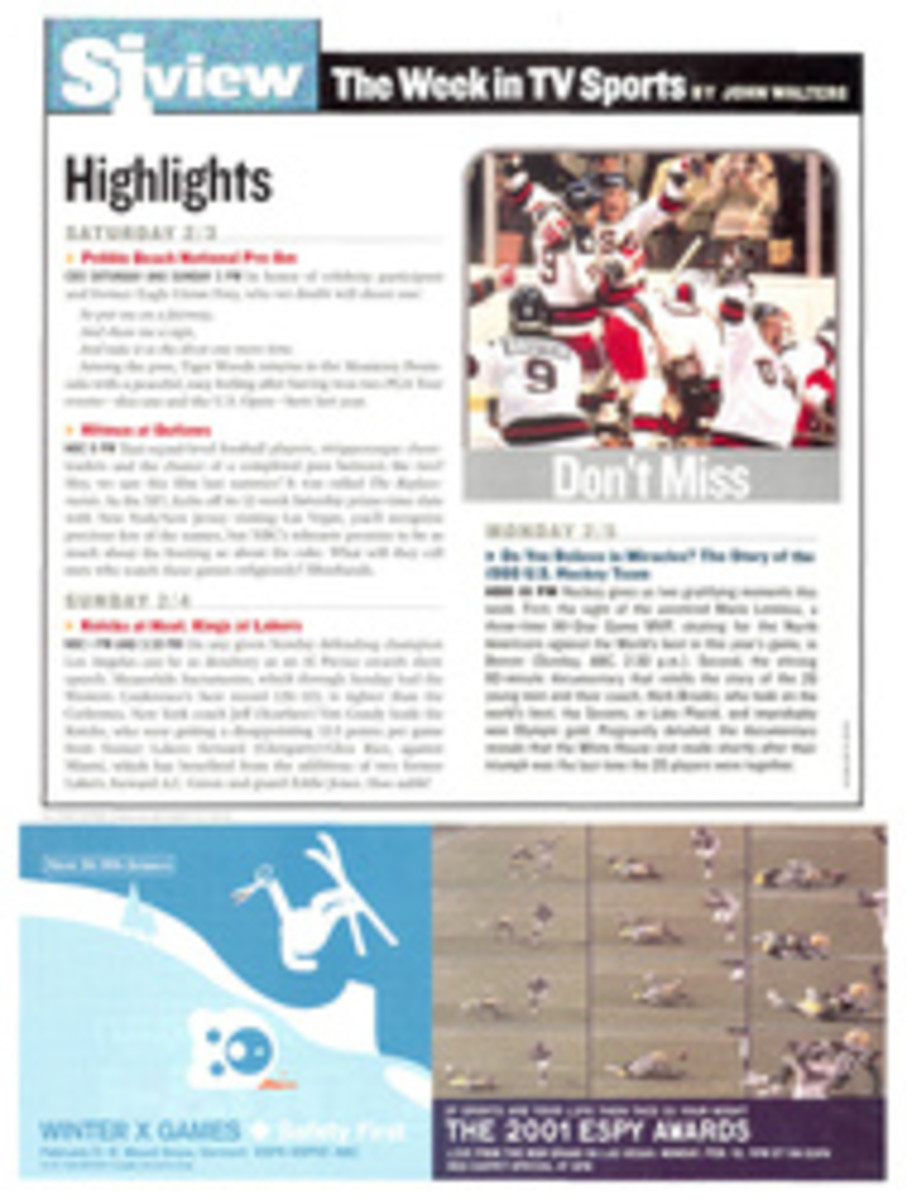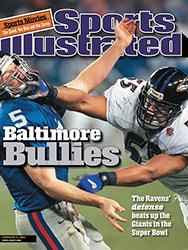
Damning Admissions Two school presidents decry college sports--and hit upon a larger problem
Almost from the day that Rutgers and Princeton played the first
intercollegiate football game, in 1869, educators and other
sensible American people have decried the overemphasis of sport
as contrary to the mission of higher education. Nothing, in fact,
is more predictable (and hypocritical) than the periodic bouts of
disgust that American college presidents exhibit when they decide
to discover once again that--egad!--big-time college football and
basketball corrupt education, serving no worthy purpose but to
keep illegal bookies profitable and industrious sorts from Dick
Vitale to Mike Krzyzewski to Nike (to, yes, the publisher of
SPORTS ILLUSTRATED) in high cotton.
The myths that college sports 1) make money for their schools or
2) encourage more contributions from infatuated alumni were
exploded long ago. (In the most recent particular, alumni giving
even shot up at Indiana after Bob Knight was fired.) Nobody
really disputes the fact that high-profile college sports are an
expensive excess and an educational anomaly, as academically
useless as teats on the male. Even Walter Byers, the perennial
NCAA executive director, retired a few years ago and then wrote a
book essentially saying that his whole professional life had been
a lie, that the college sports cartel he had run for decades was
a fraud.
However, for all the weeping and wailing and gnashing of teeth,
nothing much gets done. The Knight Commission on Intercollegiate
Athletics, a feel-good collection of prominent university
presidents and former presidents (as well as some business
leaders and Knight Foundation trustees), has pompously
reconvened, decrying and proposing. But James Duderstadt, a
former president of Michigan (perhaps the grandest athletic
program under one academic roof), addressed the Knight brethren
recently, and he sees the reality. In his recent book,
Intercollegiate Athletics and the American University, Duderstadt
states baldly what everyone knows well--that presidents will never
dare grapple with the athletic monster in their midst. Duderstadt
writes, "Intercollegiate athletics today has such a low relevance
to the rest of university life, and its problems seem so
intractable, few presidents choose to fight a battle in which the
personal risks are so large and the chances of success seem so
remote." (Or, more accurately, nonexistent.) Athletic abuses in
education are essentially protected in perpetuity precisely
because everybody else looks to the presidents to do something,
and they can't. Or they won't. So the fix is forever in.
But Duderstadt has written, with feeling, a very frank book that
lays out the case against big-time football and basketball. It
doesn't much improve on the same argument we've been hearing for
132 years, and it includes the usual wistful register of
dream-on suggestions, but it is a comprehensive indictment, and
coming from someone who endured in despair in the belly of the
beast, it means all the more.
Another former college president, William Bowen, has written a
much more controversial volume, The Game of Life: College Sports
and Educational Values. Bowen, who was president of Princeton,
cowrote the book with James Shulman, a colleague at the Mellon
Foundation, where both men are officers. What is striking about
the Bowen-Shulman study is that it posits the original thesis
that college athletics soil not only the ESPN-U's that offer
athletic scholarships, but all American colleges. Their
contention--backed with compelling statistics--is that our devotion
to rah-rah school sports is such that it is tarnishing even our
most prestigious Ivy League universities and elite, tiny
institutions as select as Williams and Hamilton and Swarthmore.
(At the last of those, you will recall, a veritable alumni
firestorm was unleashed in December when the trustees voted to
abandon a Division III football team whose most distinguishing
characteristic was losing games.)
Using statistics dating back to 1951 on 30 diverse colleges, from
Bryn Mawr and Tufts to Notre Dame and Michigan, Bowen and Shulman
make the case that athletes have become some sort of insulated
testosteronic mandarin society. Accepted instead of far better
students, they take up large numbers of places and are even far
more likely to be admitted than two other groups of sanctioned
affirmative-action candidates--alumni legacies and racial
minorities. Moreover, athletes get so wrapped up in sports that
they don't perform up to their limited predicted academic
potential, and they tend to segregate themselves from the rest of
collegiate life.
The trend is toward even greater differentiation and separation.
The Bowen-Shulman figures show, for example, that college
athletes in 1951 were very much like their fellow students, both
in their broad interests and their grades. Also, to prove that
you can't be a little bit pregnant, Bowen and Shulman offer
conclusive statistics showing that women athletes at all schools
are beginning to mimic the behavior of male athletes.
Although written coolly, almost too dispassionately, The Game of
Life presents the greatest condemnation of college sports--of the
academic athletic life--ever tendered. It may well be the most
important book about sports of this generation, on a par with
Andrew Jennings's The Lords of the Rings, which exposed the IOC
as an insider's scam. Precisely because the book is so damning
and controversial, the athletic establishment is already
beginning to fire back. The most vocal critic is, in fact, a
close and longtime friend and former colleague of Bowen's, Gary
Walters, the Princeton athletic director.
Walters maintains that any number of statistics in the book are
taken out of context--that athletes, for example, are not admitted
in the high percentages claimed, because coaches submit only
candidates most likely to be accepted. What single group
traditionally gets the highest percentage of affirmative-action
admittance, Walters asks. Not athletes, he says. No. The dirty
little secret is that it's faculty children. Hmmm.
Furthermore, he argues, we should not be surprised that athletes
have lower grades, because so many of them come from backgrounds
in which they have not had sufficient academic or family support.
Finally, Walters argues, Bowen and Shulman have romanticized the
cohort they studied from the 1950s, when grades were lower across
the board and preppies had the path into places like Princeton
greased for them. To compare today's collegiate meritocracy with
mid-century America's old-school-tie aristocracy is, Walters
says, specious.
Probably the most intriguing aspect of The Game of Life is that
it questions colleges' current predilection for choosing the
student who excels in one area over the well-rounded student.
Walters does not dispute that, sure, athletes are specialists who
tend to hang out with their own kind and have little connection
with the broad campus atmosphere. Nevertheless, he claims, had
his friend Bowen also studied groups of collegiate dramatists or
musicians or journalists, he would have found that they, too,
isolate themselves within a familiar subgroup. Our colleges may
be turning into (as Bowen and Shulman quote the economist Jacob
Viner) abodes for trufflehounds, who are "finely trained for a
single small purpose and not much good for any other."
Fachidioten, specialty idiots, the Germans call them.
So, in studying the effect of athletics on college, we may well
have stumbled onto a larger truth, that the American college is
being threatened by a kind of fragmentation that goes like a
dagger to the heart of what a college is supposed to be. Maybe we
have come full circle and have to conclude ruefully that the only
thing that really identifies an American college anymore is its
sports teams--even if they don't have anything to do with
education.
The athletes are playing games and the engineers are in the lab
and the computer nerds are writing programs and the pre-lawyers
are watching Court TV. Only nobody is going to college anymore,
nobody is being collegial. No wonder everybody cares so much
about the college basketball games. The college itself may not be
there anymore.
COLOR ILLUSTRATION: ILLUSTRATION BY DAVID SUTER
Bowen and his co-author argue that big-time athletics soil not
only the ESPN-U's but all colleges.
Colleges are threatened by a kind of fragmentation that goes
like a dagger to their heart.

